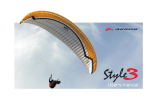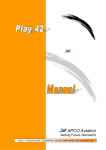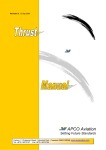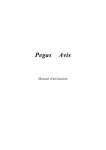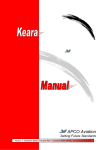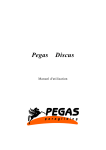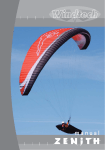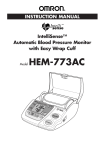Download Owners Manual
Transcript
Owners Manual AEROS Mirage 2013 Table of Contents 1. Introduction 2. Technical description 2.1. Technical data 2.2. Canopy and Lines 2.3. Risers and Speedsystem 2.4. Harness 3. Flight 3.1. Preflight Check and Launch Preparations 3.2. Turns 3.3. Spiral Dive 3.4. Turbulence 3.5. Flying with Speed System 3.6. Landing 3.7. Tow Launching and Motorized Flight 4. Flying Characteristics 4.1. Trim Speed and Best Glide 4.2. Minimum Sink Rate 5. Extreme Flying Maneuvers 5.1. Asymmetric Front Collapse 5.2. Symmetric Front Collapse 5.3. Line Over 5.4. Deep Stall 5.5. Full Stall 5.6. Spin 6. Rapid Descent Techniques 6.1. Big Ears 6.2. Spiral Dive 6.3. B-line Stall 7. Maintenance and Repairs 7.1. Folding Away 7.2. Storage 7.3. Cleaning 7.4. Repair 7.5. More 8. Drawings and Measurements 9. Contact 1. Introduction First of all we congratulate you with buying your new AEROS Mirage and wish you many enjoyable and safe flights. Please read this manual carefully before flying your Mirage. Mirage was developed as a Cross-Country and recreational glider for advanced pilots– a wing with easy handling and high in-flight stability. It is ideal for pilots flying for fun and looking for a maximum safety combined with performance enough for XC flights. Paragliding is an amazing sport but can be dangerous and lead to injury or even death. Do not pass the margins of safety – do not fly in strong turbulence and winds. Obtain your flying experience step by step, best of all under supervision of more experienced pilot. If possible, enter SIV courses – it should greatly help you in future. We produce our paragliders and equipment at our own facilities and check each step of production. This gives us a possibility to produce canopies of excellent quality with precise characteristics. At the time of delivery Aeros Mirage meets the requirements of EN 926-2. Any alternations to the paraglider will make certification invalid! Pilots are responsible for their own safety and their paragliders airworthiness. The manufacturer and distributors accept no liability for damage caused by or to the paraglider. And of course the pilot must have a valid paragliding license. 2. Technical Description 2.1. Technical Data Mirage S Cells Area m² Span m Aspect ratio Area projected m² Span projected m A/R projected Take off weight* kg Certification Vmin, km/h Vtrim, km/h Vmax, km/h M L XL 27,5 12,85 29,5 13,3 57 24,5 12,15 25,93 12,5 6 21,63 22,9 24,28 26,1 10,08 10,37 10,68 11,1 95-115 105125 4,7 75-90 85-100 EN С 24 38-39 54-56 * Pilot + ca. 17kg of equipment (incl. canopy) 2.2. Canopy and Lines Mirage is a full 3-liner. This line scheme allowed to decrease drag significantly. For our canopies we use the best materials we can buy. Ribs (mostly tensioned part) are made from NCV Porcher hard finish fabric. NCV Porcher with medium finish is used for top and bottom panels. Trylam reinforcements combined with plastic stringof ribs provide extra stability of leading edge and ease the inflation of the canopy. Lines with superaramid core and polyester coating show excellent results during laboratory and flight tests. For main suspensions are used: - top stage – diam. 1.1mm (90Kg) and 1.2mm (130 kg) - bottom stage A and B – diam. 1.9 mm (320kg) - bottom stage C and middle stage – diam 1.5mm (170 kg) - break lines top and middle – Dyneema diam. 1.1mm (85 kg) Mirage uses a newly designed airfoil, which was chosen among other types during intensive tests. Combined with proper design of the wing it gives high stability, gentle behavior during collapses, pleasant inflating characteristics and excellent handling. 2.3. Risers and Speedsystem. The Aeros Mirage is equipped with 3-risers V-lines (with baby “A” for big ears). Lines are connected to risers by quick links – triangular carabines, fitted with a twisted rubber ring preventing any slipping of the lines on the triangles. Carabines are covered with thermoforming tube, which prevents suddenly unlock of quick links. Speedsystem of Aeros Mirage is foot-operated. It changes proportionally the length of A and B risers (see Fig.) which allows to sustain the proper shape of the wing at high speed. To fit the speed system pass free ends of speed system cords (opposite ends are attached to the bar): through metal rings attached to rubber ropes (if your harness is equipped with them); through pulleys sewing to your harness. Connect loops of the cords to a small “O”-shape quick links with nuts which should be on the speed system ropes of risers. Please be sure that rope of accelerator comes from the harness to risers from outer side of risers. Test your speed system on the ground for the correct length of the cord, sitting in your harness with attached risers. The maximum speed is reached when pulleys on the A-risers are joined together. We recommend to use for attachment of speed system only quick link with nut (not a spring carabiner without securing of tongue) to prevent catching of main paraglider lines by this carabiner. To increase your speed in the air just push the bar by your feet. The loop on the speed bar is made to help you to catch the bar by your heel. 2.4. Harness Harness with a hang point at approximately chest height may be used for flying with Mirage. (42 cm from carabines to the seat) Distance between risers should be adjusted as stated in the certification stickers (this distance is different for different canopy sizes). 3. Flight 3.1. Preflight check and launch preparations It must be a rule to check lines, risers and canopy for tears and damage before each flight. Also check your harness for damages, check knots on the brake handles, check carabines attached properly and secured. Check your reserve deployment handle with security pins. Lay the canopy in a half moon shape against the wind. This will allow A-lines in the center to be tensioned before the other “A”-s. So the canopy will be inflated gradually beginning from the middle sections and the possibility of non-horizontal inflation decreases. Pull the lines slightly and sort them into A,B,C and brakes beginning from the risers. For easy control A1 and A2 risers on Aeros Mirage are marked with red, B-risers – with yellow. The brake lines should run freely through the pulleys to the trailing edge of the canopy. Important to check, that no lines are looped around the canopy (“lineover”). Check that there are no sticks or another things catched by the lines. 3.2. Launch - Forward launch: Hold A-risers (A1 and A2) with brake handles in your arms, keeping B, C risers in the arm bow. Pull up the canopy progressively. When the canopy is above your head you should feel the reduction of drug – in that moment release the A-risers. In case if you pulled the canopy too fast it should be necessary to apply the brakes slightly to prevent the forward surge. Move your body to the center of the glider to correct the roll if necessary. Now you should visually check that the canopy is fully inflated and that the lines go properly and without tangles. If anything is not correct – do not launch (abort and try again). - Reverse launch: You should use this method for windy conditions. It is recommended to practice the reverse launch on a training hill to obtain a feeling of the canopy. To avoid drag (when aborting a launch in a strong wind) use rear risers (not brakes). Using the brakes will increase lift and it should be more difficult to keep your balance. 3.3. Turns. Aeros Mirage has easy and responsible handling. The most effective turning method is the simultaneous weight shift and pulling the inside brake. To increase the wing resistances to collapses in turbulence and to obtain an optimum sink rate pull slightly the outside break while thermalling. !ATTENTION: apply breaks smoothly. Don’t pull brakes too fast or too hard – it can result in the negative spin. 3.4. Spiral Dive. To enter a spiral dive on Aeros Mirage you should slowly apply brakes of one side. While a bank angle increases – apply more brake. Control this angle by increasing or reducing the amount of inside brake. Use also a weight shift to make entry to a spiral dive easier. To exit – release brake gently. !ATTENTION: while entering a spiral dive – don’t pull inside brake too fast – it should result in a negative spin. Brake application should be in conformity with G-force and bank angle. Be careful with extra G-force – both you and your canopy should be overloaded. 3.5. Turbulence. In turbulence pilots prevent tucks by braking slightly. Forward movement of the canopy can be countered by pulling brakes. Backward movements – by letting the brakes go. 3.6. Flying with speed system. Using a speed system lowers the angle of attack of a canopy which results in the decreasing of glider stability. Push the bar smoothly. If you feel the decreasing of pressure on the bar – it means that the leading edge of your canopy is close to collapse – release the bar gently and apply brakes to counter collapses. Try not to use speed system in turbulence. When you fly with pulled accelerator – you can use for turning or to maintaining direction or to compensate forward surges the “C” lines instead of breaks. This will reduce drag coused by use of breaks. But please remember that shift of “C” lines should be much less than of breaks. 3.7. Landing. Mirage is easy to land. Plan your landing approach from a sufficient height. The final leg should be against the wind and with brakes slightly pulled down from trim position to avoid tucks. Begin to apply brakes harder at 1-1.5m above the ground so that you’ll pull full brakes just before touching ground. Stronger wind in the landing zone requires less brakes be applied. When the wind is more than 6-7 m/s to deflate the canopy pull C-lines when you’ll touch the ground. Using brakes in strong wind conditions should result in lifting the pilot and dragged him backwards. 3.8. Tow Launching and Motorized Flight. Aeros Mirage is suitable for tow launching and flying with rucksack engine. Some types of rucksack engines need longer brake lines. Adjust your brake before flight. 4. Flying Characteristics. 4.1. Trim Speed and Best Glide. Trim speed is a speed with brakes up. Depending on the pilot’s weight it should be in the range of 37-38 km/h. Aeros Mirage shows the best glide angle in a still air without brakes and speed system applied. 4.2. Minimum Sink Rate. Glider achieves minimum sink rate when applying about 20-30% of brake length. Try to feel this brake amount in a calm air to be sure that you will not cause a parachutal stall during a thermal flying. 5. Extreme Flying Maneuvers. 5.1. Asymmetric Front Collapse. Most of tuck situations are caused by turbulence (thermal activity, rotors or mixture of the above). After asymmetric front collapse the canopy begins to turn to the side of tucked wing. Usually Aeros Mirage reinflates without pilot intervention smooth and fast. To quicken canopy inflation pilot must: a) counter the turn by pulling slightly the opposite to the turn brake and shift his (her) weight to stop the turn. This action will increase speed of the deflated wing and helps it to reinflate. But don’t pull the brake too hard – be aware of stall. b) pumper the deflation by slow (1 second), long pump on the brake of deflated wing. This will accelerates the recovery of the canopy. In any case don’t rely upon the canopy will recover itself – try to accelerate this process, especially on a small altitude. 5.2. Symmetric front collapse. Symmetric front collapse occur when flying in a very turbulent air. Use active type of flying (counter all forward and backward canopy movements with light brake inputs) to prevent frontal tucks. If it happens – the canopy will recover on one's own. Brake input will stop longitudinal swings faster. 5.3. Line Over. We never experience line over during any of our flight tests on the Mirage. But theoretically it’s possible that collapsed wing tip should be caught between the lines due to turbulence or incorrect pilot behavior. Line over leads to a spiral dive. If line over occurs – try to stabilize the glider at a straight flight by gentle brake input. Then try to make one of the next procedures: a) pump a collapsed area; b) pull an ear line to untangle the stabilizer; c) in case of enough altitude – provoke a full stall (see item 5.5); d) if all of above mentioned doesn’t help – use your rescue. 5.4. Deep Stall. It should occur when you pull slowly both brake lines until the canopy will have no more forward speed – the sail bends between the lines which means the loss of internal air pressure. To exit from this situation – release brakes slowly. Mirage will recover fast. In case if the recovery delays (due to a turbulence etc) – pull A-risers slightly or use a full stall maneuver (see item 5.5). 5.5. Full Stall. To provoke a full stall it’s necessary to pull both brakes down all way long until the canopy suddenly falls backwards. It should not be habitual for you but don’t release brakes immediately. Wait until the canopy will stabilize above your head. Releasing brakes too early (when the canopy surges backwards) will cause a big forward movement of the canopy which can result in a frontal collapse. Know that it should be a big force on the brakes at that moment. Now you can release brakes gently but not very slow (approx. during one second). Apply brakes symmetrically to avoid tucks. 5.6. Spin Usually spin occur when one side brake is being pulled too hard at not enough speed. To enter this situation expressly – flying at a speed slightly higher than V min, pull one brake hard and release an opposite one. !ATTENTION: Never do this maneuver near the ground and without sufficient experience. To recover – release pulled down brake and be prepared to prevent asymmetric collapses which should be occurred during a recovery from spin. 6. Rapid Descent Techniques. 6.1. Big Ears With “big ears” sink rate of your paraglider increases approx. to 4m/s whereas horizontal speed remains the same. This technique is used to leave away a strong cloud lift, dynamic lift on the ridge or to shorten landing approach. To make big ears, pull left and right A-risers (AII) about 30-40cm downwards. !ATTENTION: do not pull AII too much in order not to pull A1. With big ears you may turn by weight shift. Applying brakes will result in exiting from big ears. Braking too much should provoke a stall earlier than without big ears. !ATTENTION: never do big ears while you are making spirals. 6.2. Spiral Dive Spiral dive is another method of increasing significantly a sink rate. Read §3.4. about the technique of spiral dive. Because of growing of G-force don’t use this method in a turbulent conditions to prevent the overloading of the glider. 6.3. B-line Stall Pull down symmetrically left and right B-risers until the canopy will enter a B-Stall. The canopy will enter a vertical descent flight with a sink rate about 8-10m/s without horizontal speed. Don’t pull B-lines too much it should cause to the horseshoe shape of the canopy. To exit from B-line stall – release B-risers fast but not sharp. Releasing B-risers slowly will extend the time of returning to a normal flight. Don’t apply brakes for 2-3 seconds after releasing brakes – the canopy must gain it’s normal horizontal speed. We never experience situation when Mirage doesn’t exit from B-line stall. But if such will occur – use a full stall to return to a normal flight. !ATTENTION: practice in all rapid descent maneuvers in a stable air with enough of altitude with supervision of more experienced pilot. 7. Maintenance and Repairs. 7.1. Folding Away. Sort the lines and put them on to the canopy. Put V-lines out of the canopy. Fold the canopy from both wingtips towards the middle until a strip 50-60cm. Roll it from trailing edge and secure by a strap. 7.2. Storage. Store your paraglider away from UV-exposure in a dry, not overheated place. Never leave a canopy wet for a long time – it will shorten fabric and lines lifetime. 7.3. Cleaning. Clean the canopy only with a fresh not hot water. Do not use chemicals. Birds droppings should be removed and the spot should be carefully rinsed in a fresh water and dried. 7.4. Repair. Repairs must be made only by the manufacturer, distributor or authorized workshop. 7.5. More. UV-exposure can seriously decrease the strength of fabric. When not flying – always try to prevent your canopy from the sun rays. Put a canopy into bag when you have break in flights. Remember that clouds are not an absolute obstacle for UV-exposure. For Mirage we use a special paraglider fabric. It is much more resistible to abrasion than other types of fabric. But instead of that, try to minimize rubbing of your canopy with the ground. Always rinse the glider in a fresh water (outside and inside of the canopy) after contact with a salt water. Crystal salt weaken lines and fabric strength. While it’s possible to rinse fabric but it’s quite difficult to rinse lines in full. So we recommend to change all lines after being in salt water. When folding paraglider on the grass – look carefully to avoid insects be folded inside the canopy. Grasshoppers and other big insects can gnaw through the sail looking for freedom.











